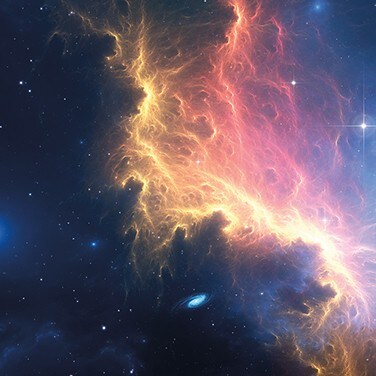Discovering Dark Matter
Two Experiments Get Closer to Finding What Makes Up Much of the Universe
By Mark Miller.
Scientists believe that over a quarter of the universe is dark matter. But because it is composed of a substance that doesn’t absorb, reflect, or emit light, dark matter is extremely difficult to find. In fact, the Standard Model — science’s best theory of the universe’s building blocks and how they interact — is mysteriously quiet on the topic.
Findings from two experiments, however, may shed new light: one by defying predictions of the Standard Model and the other by discovering potential dark matter particles as they collide with regular atoms.
Wobbling Muons
The Muon g-2 experiment conducted at Fermi National Accelerator Laboratory, or Fermilab, found further evidence that the behaviour of subatomic particles called muons may not obey the predictions of the Standard Model.
A muon is like an electron, but about 200 times as massive. Also, like an electron, a muon acts as if it has an internal magnet. When travelling through a magnetic field, the muon spins and wobbles like the axis of a spinning top.
In the Muon g-2 experiment, muons travel around and around a 50-foot-wide ring — a sort of magnetic track. As they move through the magnetic field, their oscillations can be precisely measured. These results are compared to the predicted values. The experiment confirmed a standard deviation of 4.2 from Standard Model predictions. The discrepancy could mean the muon is interacting with particles or other energy not currently known to science — a discovery that could open a wider window into cosmic mysteries like dark matter.
Discovery by Deflection
At Gran Sasso National Laboratory in Italy, the XENONnT experiment is searching for dark particles by detecting the flashes of light they can create when deflected off xenon atoms.
The experiment uses more than eight tons of xenon contained in liquid. Should a dark particle bump into the xenon, it releases an electron. This event creates a flash of light that can be detected by an array of photomultipliers lining the liquid vat. The instruments can detect even a single photon unleashed by a dark particle deflection.
Researchers are using particle deflection to look for weakly interacting massive particles or WIMPs. Unfortunately, none have yet been discovered, but a payoff may lie in the elimination of dark particle candidates as well as their actual discovery.
“You do start to scratch your head and think maybe that was the wrong horse to bet on,” said physicist Rafael Lang in Scientific American about the search for WIMPs. But he remains optimistic. “If you believed in WIMPs 10 years ago, only half of those WIMPs have been ruled out. The other half are still alive.”(1)
"Muons could be interacting with dark particles or other energy not currently known to science."
Other Possibilities
WIMPs and the forces causing muon wobbles are just two dark particle possibilities. According to Scientific American, others include a theoretical particle called an axion. Dark matter may also be made of composite particles. Another possibility is that it might not consist of particles at all but be made of black holes. Whatever the answers, the Muon g-2, XENONnT, and similar experiments will continue to aid the search for mysterious matter.
Mark Miller is a Thermo Fisher Scientific content copywriter.
References
1. Moskowitz, C. (2021, April 1). Dark Matter’s Last Stand. Scientific American. https://www.scientificamerican.com/article/dark-matters-last-stand
This content was inspired, in part, by “Dark matter,” CERN; “Long-Awaited Muon Measurement Boosts Evidence for New Physics,” Scientific American; “First results from Fermilab’s Muon g-2 experiment strengthen evidence of new physics,” Fermilab; “A Tiny Particle’s Wobble Could Upend the Known Laws of Physics,” The New York Times; “The muon g-2 experiment might mean the Standard Model of physics is incomplete, but that’s just the beginning,” Massive Science; and “Dark Matter’s Last Stand,” Scientific American.
